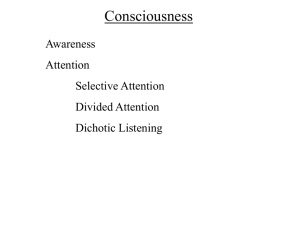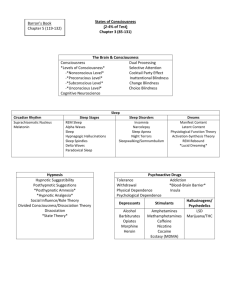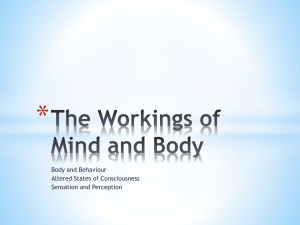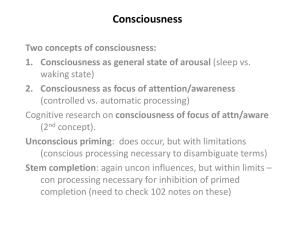K. SAcerdote A.P. Psychology APA: TOPPS
advertisement
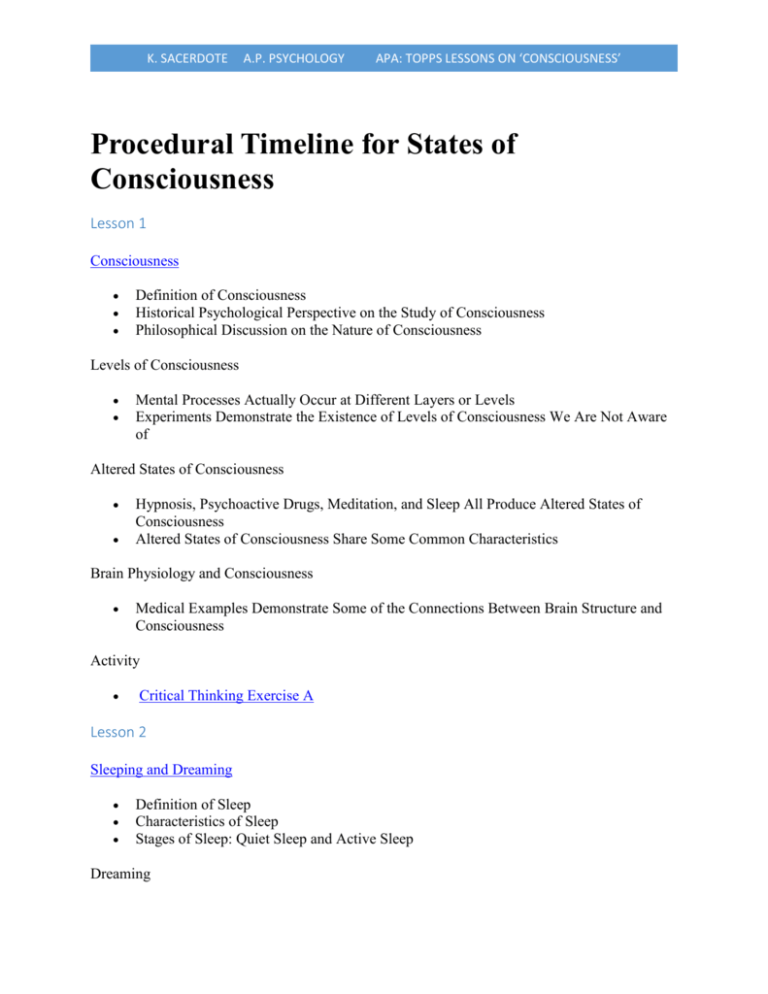
K. SACERDOTE A.P. PSYCHOLOGY APA: TOPPS LESSONS ON ‘CONSCIOUSNESS’ Procedural Timeline for States of Consciousness Lesson 1 Consciousness Definition of Consciousness Historical Psychological Perspective on the Study of Consciousness Philosophical Discussion on the Nature of Consciousness Levels of Consciousness Mental Processes Actually Occur at Different Layers or Levels Experiments Demonstrate the Existence of Levels of Consciousness We Are Not Aware of Altered States of Consciousness Hypnosis, Psychoactive Drugs, Meditation, and Sleep All Produce Altered States of Consciousness Altered States of Consciousness Share Some Common Characteristics Brain Physiology and Consciousness Medical Examples Demonstrate Some of the Connections Between Brain Structure and Consciousness Activity Critical Thinking Exercise A Lesson 2 Sleeping and Dreaming Definition of Sleep Characteristics of Sleep Stages of Sleep: Quiet Sleep and Active Sleep Dreaming K. SACERDOTE A.P. PSYCHOLOGY APA: TOPPS LESSONS ON ‘CONSCIOUSNESS’ Definition of Dreaming Theories of Dreaming Sleep Disorders Insomnia Narcolepsy Sleep Apnea Parasomnias Activities Activity 2.1 Activity 2.2 Activity 2.3 Activity 2.4 The Role of Prior Information in Dream Analysis Sleep Disorders To Sleep, Perchance To Dream Relating Body Temperature and Circadian Rhythms Lesson 3 Hypnosis and Meditation Definitions of Hypnosis History of Hypnosis Hypnotic Ability and Susceptibility Effects of Hypnosis on Memory Changes Exhibited During Hypnosis Performance of Acts Against One's Will During Hypnosis Controversy About Hypnosis as an Altered State Uses of Hypnosis Meditation Definition of Meditation Physiological Effects Correlates Mechanism Activities Activity 3.1 An Introduction to Meditation Activity 3.2 Concentrative Meditation Lesson 4 Drugs That Alter Consciousness K. SACERDOTE A.P. PSYCHOLOGY APA: TOPPS LESSONS ON ‘CONSCIOUSNESS’ Definition of Psychoactive Drugs Psychopharmacology Physical Dependence or Addiction Tolerance Psychological Dependence Learned Expectations Contribute to the Effects of Many Drugs Categories of Drugs Depressants Stimulants Opiates Psychedelics Activities Activity 4.1 Eyescube: An Addiction Simulation Critical Thinking Exercise B Lesson 1: Consciousness I. Waking Consciousness A. Definition of consciousness. Consciousness is awareness of ourselves and our environment. B. Historical psychological perspective on the study of consciousness 1. The emergence of behaviorism lessened the emphasis on the study of consciousness. 2. Consciousness as a legitimate field of psychological study re-emerged in the 1960s because of advances in neuroscience and interest in altered states of consciousness. C. Philosophical discussion on the nature of consciousness 1. Mind-body problem: This explores what the relationship is between the physical body and brain and the immaterial mind and consciousness. K. SACERDOTE A.P. PSYCHOLOGY APA: TOPPS LESSONS ON ‘CONSCIOUSNESS’ 2. Dualism: Philosopher Rene Descartes saw the mind and the brain as separate entities that interacted to produce free will. 3. Materialism: This is the view that the mind is the brain and that complex physical interactions between neurons create consciousness. II. Levels of Consciousness A. Mental processes actually occur at different layers or levels 1. Conscious level: This is the level at which a person is aware of mental events at a given moment. 2. Nonconscious level: This is the level at which a person does not normally perceive or control mental processing consciously (e.g., blood pressure). 3. Preconscious level: This is the level at which a person's mental events that are outside of his/her current awareness can be brought into consciousness voluntarily (i.e., by remembering). 4. Unconscious: This is a structure that Sigmund Freud theorized but did not prove to exist that holds repressed memories/desires. Carl Jung believed that the unconscious mind is connected with a collective unconscious that contains ancestral memories B. Experiments demonstrate the existence of levels of consciousness we are not aware of 1. "Priming": This is the term used for the phenomenon that people respond more quickly and/or accurately to stimuli they have previously experienced. 2. "Mere-exposure effect": This is the term for the phenomenon that people like seeing stimuli they have previously seen more than new stimuli, even when they do not consciously remember seeing them. III. Altered States of Consciousness. These are shifts from our normal waking state of consciousness. A. Hypnosis, psychoactive drugs, meditation and sleep all produce altered states of consciousness B. Altered states of consciousness share some common characteristics 1. Critical thinking is inhibited (e.g., a dreamer may perceive an unrealistic dream as logical while he/she is experiencing it) K. SACERDOTE A.P. PSYCHOLOGY APA: TOPPS LESSONS ON ‘CONSCIOUSNESS’ Lesson 2: Sleeping and Dreaming I. Sleeping A. Definition of Sleep: Sleep is an altered state of consciousness in which people become rela- tively, but not totally, unaware of external stimulation B. Characteristics of Sleep 1. Human sleep patterns follow a circadian rhythm corresponding to a 24-1/2 to 26 hour daily cycle in the absence of external time cues. 2. Average adults experience four to six 90-minute cycles of NREM (non-rapid eye movement) and REM (rapid eye movement) sleep per night, although the ratio of NREM to REM sleep varies as the night progresses (see Sleep Chart, Appendix A). 3. Need for sleep varies among individuals, but ranges from 20 hours for infants to 6 hours for adults in their 70s. a. Loss of sleep results in a suppressed immune system, impaired creativity and concentration, slowed performance and misperceptions on monotonous tasks. b. Benefits of sleep include restoration of energy, repairing of brain and body tissue, and release of growth hormones. 4. A sleeper progresses through Stages 1 through 4, then climbs back from Stage 4 to Stage 1 or 2, then experiences REM sleep. 5. Forty to 50 percent of sleep takes place in Stage 2, which dominates the transition phase after the first two-three sleep cycles. 6. The average person progresses through the stages of sleep 4 to 6 times per night. C. Stages of sleep: Quiet Sleep and Active Sleep 1. Stage 0: A person is relaxed with eyes closed a. EEG shows alpha waves b. This period of falling asleep is also called the hypnagogic state. c. The "waking" period between being asleep and wakefulness is called the hypnopompic state. K. SACERDOTE A.P. PSYCHOLOGY APA: TOPPS LESSONS ON ‘CONSCIOUSNESS’ 2. Quiet Sleep: This is NREM (non-rapid eye movement) sleep a. Stage 1 lasts from 30 seconds to 10 minutes (Note: All times are approximate and vary considerably in duration from person to person during a night's sleep) and is characterized by sensory images and slow rolling eye movements and recognized by the appearance of theta waves on an EEG. b. Stage 2 lasts about 20 minutes and is recognized by the appearance of theta waves, sleep spindles and K-complexes on an EEG. c. Stage 3 is the transition to Stage 4 sleep, recognized on an EGG by the beginning of delta waves. d. Stage 4 is deep sleep lasting about 30 minutes, recognized by 20-50% delta waves in an EEG reading. (Note. The amount of time spent on Stages 3 and 4 varies as the night progresses. See Sleep Chart in Appendix A.) 3. Active Sleep: This is REM (rapid eye movement) state of consciousness following a cycle of NREM sleep. a. Some researchers consider REM to be a separate state of consciousness rather than a stage of sleep. b. Nearly all dreams occur in REM. c. Dreams that occur during REM are more vivid and story-like than dreams that occur in sleep Stages 2 or 3. d. Periods of REM sleep typically increase during the night, from less than a minute to almost an hour, and they total about 25% of an average night's sleep. e. REM sleep causes atonia which is temporary paralysis of the body during REM. f. The brain seems to be active and awake while the body shows loss of muscle tone. 4. REM Sleep Function a. During REM, hormones are released that influence the thinking process and counteract fatigue, irritability and inattention. b. REM rebound is a phenomenon of increased REM sleep following a period of REM deprivation. K. SACERDOTE A.P. PSYCHOLOGY APA: TOPPS LESSONS ON ‘CONSCIOUSNESS’ 5. NREM Sleep Function During NREM sleep: the body replenishes itself physically in several ways for example, the pituitary gland releases growth hormones, and body tissues are restored. ll. Dreaming A. Definition of Dreaming: Dreaming is a series of thoughts, images or emotions usually occurring in story-like form during sleep. 1. Duration of dreaming ranges from a few seconds to a few minutes to as long as an hour. 2. Organization of dreaming is usually somewhat logical and story-like. 3. Lucid dreaming is a state of dreaming where the sleeper can direct the dream or is aware that she/he is dreaming. B. Theories of Dreaming 1. Sigmund Freud viewed dreams as wish fulfillment in which the manifest content is a censored version of the latent content. 2. Activation-synthesis theory states that the dream story results from the brains trying to interpret meaningless, periodic, random neural firings occurring during REM. 3. Problem solving/information processing theory states that dreams are caused by peoples reviewing problems they faced during waking hours. lll. Sleep Disorders A. Insomnia: This is the inability to sleep that causes daytime fatigue. 1. Causes: Causes of insomnia includes depression and anxiety disorders, stress, diet, genetics and abnormal sleeping patterns. 2. Treatments: Treaments include sleeping pills, sleep restriction therapy, and stress management. B. Narcolepsy: This is daytime sleeping disorder characterized by a sudden lapse into REM sleep and loss of muscle tension. 1. Cause: Research indicates that genetic factors may play a role and that medication often helps treat narcolepsy. Because narcoleptics fall into REM sleep immediately, the brain mechanisms that suppress REM sleep may be part of the cause of the disorder. K. SACERDOTE A.P. PSYCHOLOGY APA: TOPPS LESSONS ON ‘CONSCIOUSNESS’ 2. Treatments: Stimulants and napping C. Sleep apnea: This is a disorder in which the sufferer briefly stops breathing during sleep, wakes to resume breathing, and sleeps until the next stoppage, sometimes hundreds of times a night, resulting in daytime fatigue; more often found in men than women. 1. Causes: Causes include obesity, alcoholism and genetic factors. 2. Treatments: Treatments include weight loss and use of the nasal mask (C-PAP) while sleeping which provides a steady stream of air. D. Parasomnias 1. SIDS (sudden infant death syndrome) is a disorder in which a sleeping infant stops breathing and dies. a. Causes: Causes are unknown, a possibility is problems in how the brain regulates breathing. b. Treatments: Treatments include placing infants on their backs or sides during sleep. 2. Night terrors: There are intense frightening dreams during Stage 4 sleep, most prevalent among young boys. a. Causes: Causes are unknown b. Treatments: Treatments include medication 3. REM behavior disorder is characterized by the sleeper's physically acting out dreams, sometimes violently. a. Causes: Causes are unknown b. Treatments: Medication is one treatment 4. Jet lag is a temporary pattern of fatigue, irritability, inattention and sleeping problems caused by a change in the normal sleep routine. a. Causes: Disruption of normal sleep patterns is one cause. b. Treatment: Jet lag can be prevented or lessened by altering sleeping habits before changing sleep routine and by avoiding stimulants such as caffeine. 5. Sleepwalking (Somnambulism) is a delta-sleep parasomnia most common among young children. K. SACERDOTE A.P. PSYCHOLOGY APA: TOPPS LESSONS ON ‘CONSCIOUSNESS’ 6. Bruxism is severe teeth grinding during sleep. 7. Myclonus is the condition of sudden muscle contractions that a sleeper may experience soon after falling asleep. lV. Activities A. Activity 2.1: The Role of Prior Information in Dream Analysis B. Activity 2.2: Sleep Disorders C. Activity 2.3: To Sleep, Perchance To Dream D. Activity 2.4: Relating Body Temperature and Circadian Rhythms K. SACERDOTE A.P. PSYCHOLOGY APA: TOPPS LESSONS ON ‘CONSCIOUSNESS’ Handout 2.1 for States of Consciousness At the time of the following dream, Doris S. was a 65-year-old woman living in a Chicago suburb. She had four grown children, two boys and two girls. Her husband of 40 years died 2 years before she had the dream. Though in excellent health for decades, she had just been diagnosed as having breast cancer. Her prognosis was good, but she worried about her health. She also worried about one of her grandchildren, a boy, who was born autistic and retarded. Other than these rather unfortunate problems, Doris had lived a very normal life and had never experienced serious psychological problems. Doris's Dream "I am at my friend Betty's house. I call Ann up to make an appointment to get my hair highlighted. I speak to the receptionist at the beauty parlor. I speak in a Russian accent. She asks when I can come. I say in a couple of days. I think that might be Wednesday. She asks 'Are you sure because we are changing things around here; implying that it won't be good if I change my mind and cancel the appointment. After speaking to her, I realize that I don't need to have my hair highlighted yet, because my hair hasn't grown out yet. But George and I go on the 'A' train to the beauty parlor. It goes through a neighborhood that I have never seen before. The train travels outside. George gets out at a stop as if he nonchalantly is doing something. The train leaves without him. I wave to him and feel bad that he is not on the train." (Ullman, 1986, p. 539). Jot down notes about your interpretation of the dream in the space below: __________________________________________________________________________ __________________________________________________________________________ __________________________________________________________________________ __________________________________________________________________________ __________________________________________________________________________ __________________________________________________________________________ K. SACERDOTE A.P. PSYCHOLOGY APA: TOPPS LESSONS ON ‘CONSCIOUSNESS’ Handout 2.2 for States of Consciousness At the time of the following dream, Doris S. was an 18-year-old woman living in a rural area. She was getting ready to graduate from high school and begin the long road toward a medical degree (she would have been the first child in her family to become a doctor) when she found out that she was pregnant. Her parents were not yet aware of the situation and she and her boyfriend were in the midst of deciding whether to try to arrange an abortion or to get married, though the latter option meant the end of her medical school aspirations. Beyond these rather unfortunate problems, Doris lived a very normal life and had never experienced serious psychological problems. Doris's Dream "I am at my friend Betty's house. I call Ann up to make an appointment to get my hair highlighted. I speak to the receptionist at the beauty parlor. I speak in a Russian accent. She asks when I can come. I say in a couple of days. I think that might be Wednesday. She asks 'Are you sure because we are changing things around here; implying that it won't be good if I change my mind and cancel the appointment. After speaking to her, I realize that I don't need to have my hair highlighted yet, because my hair hasn't grown out yet. But George and I go on the 'A' train to the beauty parlor. It goes through a neighborhood that I have never seen before. The train travels outside. George gets out at a stop as if he nonchalantly is doing something. The train leaves without him. I wave to him and feel bad that he is not on the train." (Ullman, 1986, p. 539). Jot down notes about your interpretation of the dream in the space below: _________________________________________________________________________ _________________________________________________________________________ _________________________________________________________________________ _________________________________________________________________________ _________________________________________________________________________ _________________________________________________________________________ K. SACERDOTE A.P. PSYCHOLOGY APA: TOPPS LESSONS ON ‘CONSCIOUSNESS’ Handout 2.3 for States of Consciousness At the time of the following dream, Doris S. was a happy and healthy 28-year-old woman living in a comfortable Chicago condominium with her husband of 5 years. Both she and her husband had high-paying jobs in advertising (they had met at work) and were generally enjoying life as yuppies. They got along well together and, beyond the usual conflicts over small things, the only problems they had were her overbearing mother (who they perceived as trying to run their lives) and a very stressful decision about whether to move to Los Angeles, where her husband, but not she, had the opportunity for an exciting new job at even higher pay. Beyond these rather routine problems, Doris lived a very normal life and had never experienced serious psychological problems. Doris's Dream "I am at my friend Betty's house. I call Ann up to make an appointment to get my hair highlighted. I speak to the receptionist at the beauty parlor. I speak in a Russian accent. She asks when I can come. I say in a couple of days. I think that might be Wednesday. She asks 'Are you sure because we are changing things around here; implying that it won't be good if I change my mind and cancel the appointment. After speaking to her, I realize that I don't need to have my hair highlighted yet, because my hair hasn't grown out yet. But George and I go on the 'A' train to the beauty parlor. It goes through a neighborhood that I have never seen before. The train travels outside. George gets out at a stop as if he nonchalantly is doing something. The train leaves without him. I wave to him and feel bad that he is not on the train." (Ullman, 1986, p. 539). Jot down notes about your interpretation of the dream in the space below: _________________________________________________________________________ _________________________________________________________________________ _________________________________________________________________________ _________________________________________________________________________ _________________________________________________________________________ _________________________________________________________________________ K. SACERDOTE A.P. PSYCHOLOGY APA: TOPPS LESSONS ON ‘CONSCIOUSNESS’ Lesson 3: Hypnosis and Meditation I. Hypnosis A. Definiton of Hypnosis Hypnosis is an altered state of consciousness that occurs in the context of a special hypnotist subject relationship and is characterized by increased suggestibility to changes in experiences and behaviors. B. History of Hypnosis 1. Franz Anton Mesmer (late 1700s) a. Mesmer was an Austrian physician. b. Mesmer originated "Mesmerism" which is a procedure for physical disorders. i. In this procedure, afflicted body parts were thought to be cured by passing magnets over the body. ii. Some patients fell into a trance and awoke feeling better. iii. There was little scientific basis; investigated by two commissions that concluded results were due to imagination. 2. James Braid (1795-1860) a. Braid was an English surgeon. b. He coined "hypnosis" from the Greek "hypnos" (sleep). c. He explored hypnosis as a deep sleep-like state. 3. Jean Charcot (1825-1893) a. Charcot was a French neurologist. b. He explained hypnosis as a hysterical condition with three stages (lethargy, catalepsy, somnambulism). 4. Hippolyte Bernheim (1840-1919) K. SACERDOTE A.P. PSYCHOLOGY APA: TOPPS LESSONS ON ‘CONSCIOUSNESS’ a. Bernheim was a professor of internal medicine. b. He explored hypnosis as a nonpathological state in which hypnotic phenomena are primarily the result of suggestion. c. A major debate and disagreement ensued between Bernheim's followers and Charcot's followers. 5. Clark Hull (1920s) a. Hull was a professor and researcher at the University of Wisconsin and Yale University. b. He established the first experimental hypnosis lab at University of Wisconsin, Madison. c. He was the first to demonstrate hypnotic phenomena were robust in the lab. 6. During the WWI and II eras, hypnosis was used as a psychological intervention. C. Hypnotic Ability and Susceptibility 1. Openness to suggestion is key, not any special ability of the hypnotist. 2. Twenty percent of people are highly hypnotizable; 10% difficult/impossible. 3. Correlates are rich fantasy life, imagination, ability to focus attention and ignore distraction. 4. Expectancy plays a role. D. Effects of Hypnosis on Memory 1. Age regression is one effect. a. Hypnotized people are not more childlike than nonhypnotized people who are asked to feign childlike behavior. b. Inaccurate memories are common. 2. Relaxed reflection can sometimes boost recall. 3. False recollections and increased confidence in false memories often occur. 4. Memories are often constructed, and hypnotized people are susceptible to hints and suggestions. K. SACERDOTE A.P. PSYCHOLOGY APA: TOPPS LESSONS ON ‘CONSCIOUSNESS’ 5. Normal rules of memory formation, storage and retrieval apply. 6. Hypnotically induced memories may be unreliable, which many therapists fail to appreciate. 7. Posthypnotic amnesia is a condition in which a person is supposedly unable to recall what he or she experienced while hypnotized. E. Changes Exhibited During Hypnosis Changes include: 1. Reduced planfulness and lack of initiation 2. Redistributed attention 3. Vivid imagination and fantasizing 4. Increased role-testing 5. Reduced reality testing F. Performance of Acts Against One's Will During Hypnosis 1. Hypnotized people are not more likely to perform antisocial acts than people who are asked to simulate hypnosis. 2. An authoritative person in a legitimate context is sufficient to induce unlikely acts. G. Controversy About Hypnosis as an Altered State 1. Role and social influence theories suggest that: a. Hypnosis is not a special or altered state of consciousness, but merely a person's complying with social demands and acting a social role. b. Hypnosis is not a unique physiological state. c. Nonhypnotized persons can duplicate many aspects of behavior of hypnotized persons. 2. Altered state/divided consciousness theories suggest that: a. Existence of phenomena such as pain reduction and hallucinations suggest that hypnosis is an altered state of consciousness. b. Divided consciousness (Ernest Hilgard) is K. SACERDOTE A.P. PSYCHOLOGY APA: TOPPS LESSONS ON ‘CONSCIOUSNESS’ i. A special state of dissociated (split) consciousness. ii. In which normally centralized thoughts and actions are temporarily reorganized. iii. In which the subject is aware of experiences that go unreported during hypnosis (hidden observer). H. Uses of Hypnosis 1. Some clinicians use posthypnotic suggestion to help patients control undesired symptoms and behaviors; a posthypnotic suggestion is a suggestion made during a hypnosis session to be carried out after the subject is no longer hypnotized. 2. Hypnosis is used for pain control. 3. Hypnosis is used as part of treatment therapies. a. It is used in the treatment of headaches, asthma, warts, stress-related skin disorders, self-control problems such as smoking, weight control and nail biting. b. It is unclear whether the benefits of hypnosis surpass the benefits of mere positive suggestion without hypnosis. II. Meditation A. Definiton of Meditation Meditation is a technique designed to create an altered state of consciousness characterized by inner peace and tranquility. It is attention focused on one thing, often a word or sound or object, until thoughts slow or stop. B. Physiological Effects These include slower breathing, slower heart rate, lower muscle tension, lower blood pressure, lower oxygen consumption, alpha-wave EEG activity pattern found in relaxed, eyes-closed waking state. (EEG studies have found that 40% of time spent meditating subjects are actually sleeping.) C. Correlates These are reduced anxiety levels, lower resting blood pressure, reduced insomnia, improved self-esteem and social openness. D. Mechanism 1. It is unclear what causes the health and emotional effects. K. SACERDOTE A.P. PSYCHOLOGY APA: TOPPS LESSONS ON ‘CONSCIOUSNESS’ 2. The same effects can also be attained by biofeedback, hypnosis and simple relaxation. III. Activities A. Activity 3.1 An Introduction to Meditation B. Activity 3.2 Concentrative Meditation Lesson 4: Drugs That Alter Consciousness I. Drugs and Altered Consciousness A. Definition of Psychoactive Drugs These are drugs that affect the brain and change consciousness and other psychological processes. 1. Most affect the brain by altering the interaction between neurotransmitters and receptors. 2. Drugs must cross the blood-brain barrier, a feature of the blood vessels in the brain that prevents substances from entering brain tissue. 3. Agonists bind to the receptors and mimic effects of normal neurotransmitters. 4. Antagonists bind to the receptors and prevent the normal neurotransmitters from binding. 5. Other drugs work by increasing or decreasing release of specific neurotransmitters. B. Psychopharmacology This is the study of psychoactive drugs and their effects on behavior and mental processes. C. Physical Dependence or Addiction This is a physiological state in which drug use is necessary to prevent a withdrawal symptom. D. Tolerance This is a condition in which increasingly large drug doses are necessary to achieve the same effect. K. SACERDOTE A.P. PSYCHOLOGY APA: TOPPS LESSONS ON ‘CONSCIOUSNESS’ E. Psychological Dependence This is a condition in which the person continues drug use despite adverse effects, needs the drug for a sense of well being, and is preoccupied with obtaining the drug if it is no longer available. F. Learned Expectations Contribute to the Effects of Many Drugs II. Categories of drugs A. Depressants Depressants reduce the activity of the central nervous system and increase the activity of the inhibiting neurotransmitter gamma-amino-butyric acid (GABA). 1. Alcohol causes memory problems, poor motor coordination and can suppress breathing and heartbeat to the point of fatality. a. Genetic factors may contribute to an inhibition of, or predisposition to alcohol dependence. b. High potential for physical and psychological dependence. 2. Barbiturates cause relaxation, mild euphoria, loss of muscle coordination and lowered attention. a. Withdrawal symptoms can be severe. b. Examples include sleeping pills and "downers". c. High potential for physical and psychological dependence. 3. Anxiolytics cause relaxation, anxiety reduction or sleep. a. They cause GABA to bind more effectively to receptors. b. They can result in severe withdrawal symptoms. c. With long-term use they can cause panic, confusion, anger and memory loss. d. Examples include Librium, Valium and other tranquilizers. e. A high potential exists for physical and psychological dependence. B. Stimulants Stimulants increase behavioral and mental activity. K. SACERDOTE A.P. PSYCHOLOGY APA: TOPPS LESSONS ON ‘CONSCIOUSNESS’ 1. Amphetamines stimulate the brain and the sympathetic branch of the autonomic nervous system, raise heart rate and blood pressure, constrict blood vessels, shrink mucous membranes, reduce appetite, and increase alertness and response speed. a. Amphetamines increase the release and decrease the removal of norepinephrine and dopamine at synapses, increasing activity at these receptors. 2. Cocaine causes euphoria, self-confidence and optimism. a. It increases norepinephrine and dopamine activity similar to amphetamines. b. Its use can lead to nausea, overactivity, insomnia, paranoia, hallucinations, sexual dysfunction, seizures, heart attack, stroke and behavior problems in babies exposed to cocaine during mother's pregnancy. c. It includes derivatives such as crack, which is a purified, fast-acting, potent, smokeable form. d. A high potential exists for physical and psychological dependence. 3. Caffeine reduces drowsiness, improves problem-solving ability, increases capacity for physical work, raises urine production, induces anxiety and causes tremors. a. Caffeine is found in coffee, tea, chocolate, some soft drinks and may be the world's most popular drug. b. Withdrawal symptoms include headaches, fatigue, anxiety, shakiness and craving. c. A moderate potential exists for physical and psychological dependence. 4. Nicotine causes elevated moods, improved memory and an increase in attention. a. It works as an acetylcholine agonist and increases the release of glutamate. b. It is a major ingredient in tobacco. c. Withdrawal symptoms include craving, anxiety, irritability and lowered heart rate. d. Its use constitutes a major risk for cancer, heart disease and respiratory disorders. K. SACERDOTE A.P. PSYCHOLOGY APA: TOPPS LESSONS ON ‘CONSCIOUSNESS’ 5. MDMA (methylenedioxymethamphetamine), or "Ecstasy", causes visual hallucinations, dry mouth, hyperactivity, muscle aches, fatigue, depression and poor concentration. a. It increases activity of dopamine-releasing neurons, and is a serotonin agonist. b. Its negative effects include permanent brain damage and development of panic disorder. c. A low potential for physical and psychological dependence. C. Opiates Opiates relieve pain and cause euphoria and relaxation. 1. Opium relieves pain and causes relaxation and feelings of well-being. a. It is derived from the poppy plant. b. It carries a high potential for physical and psychological dependence. 2. Morphine relieves pain and causes euphoria. a. It is derived from opium. b. A high potential exists for physical and psychological dependence. 3. Heroin relieves pain and causes euphoria. a. It is derived from morphine, but 3 times as powerful. b. A high potential exists for physical and psychological dependence. D. Psychedelics Psychedelics cause loss of contact with reality; alter emotions, perception and thought; and can cause hallucinations. 1. LSD (lysergic acid diethylamide), or "acid", causes hallucinations, short-term memory loss, paranoia, violent outbursts, nightmares, flashbacks and panic attacks. a. It is a serotonin agonist. b. It was developed by Swiss chemist Albert Hoffman in 1938. c. Users develop a tolerance for it. K. SACERDOTE A.P. PSYCHOLOGY APA: TOPPS LESSONS ON ‘CONSCIOUSNESS’ d. A low potential exists for physical and psychological dependence. 2. Marijuana causes euphoria, relaxation, food craving, time distortion and an increase in vivid sensations. a. Its active ingredient is tetrahydrocannabinol (THC), which accumulates in fatty deposits in organs and the brain, affecting receptors sensitive to anandamide. b. It originates from the hemp plant (Cannabis sative). c. Negative effects include disruption of memory formation and muscle coordination, motor skills impairment, lowered academic achievement, confused reasoning skills and harm to a developing fetus. d. A low potential exists for physical dependence, moderate potential for psychological dependence. 3. PCP (Phencyclidine piperidine), also known as "Angel Dust," causes euphoria, halluci- nations, distorted sensations, violent tendencies and a masking of pain. a. Negative effects include respiratory depression, generalized seizure activity, pulmonary edema and self-inflicted injury due to the complete masking of pain and tendency to violent activity. b. A high potential for physical and psychological dependence. III. Activities A. Activity 4.1 Eyescube: An Addiction Simulation B. Critical Thinking Exercise B
